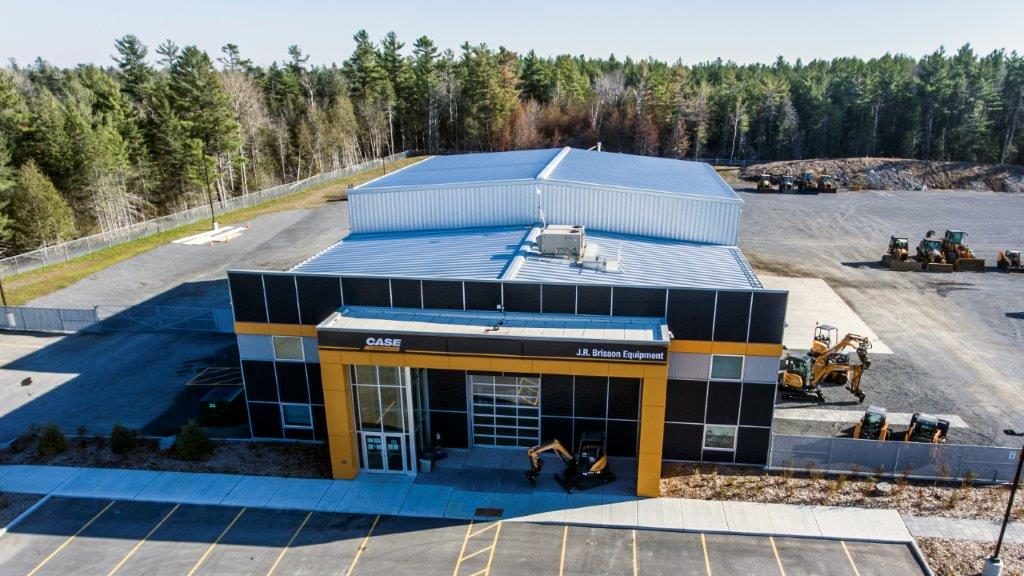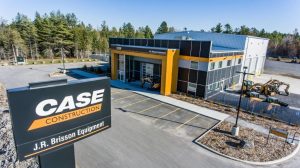
Download a PDF copy of this Case Study
J.R. Brisson Equipment has operated in the construction and snow removal equipment industry for many years as a CASE Construction Equipment dealership servicing Eastern Ontario and Western Quebec. With more than 50 employees in three different locations, the company is well-known for offering personalized service and great expertise to their customers. Since 2017, J.R. Brisson Equipment has been part of the Terapro Group, which counts 16 locations supporting the CASE Construction and New Holland Agriculture brands in Quebec and Ontario.
The construction of a new location in Stittsville, a suburb of Ottawa, aimed to increase their presence in the territory, allowing the company to continue offering exceptional service to their existing and future customers. The enterprise recognized a need to relocate its Ottawa location in the west end of the city and decided to build a brand-new office and shop. To tackle the project, Argue Construction, owned and operated by Shawn Argue, was tapped to oversee the construction.
Argue Construction, a longstanding Robertson Building Systems builder, assessed the project needs and determined that a Robertson metal building system would be the most appropriate, cost-effective solution for the construction, which included a front office space and a shop in the back that needed to accommodate a single 10-ton overhead crane and other equipment. The office and shop had to be separated by a firewall that Robertson needed to provided support for. Details of the firewall had to be carefully thought out. The overall design and product choices were determined through a collaborative effort between Shawn’s strong design-build team, the architect and the Robertson team.
Shawn explains the process: “We started with some back-and-forth conversations about the overall design and requirements for the project. Then, the finer details came through from Robertson on their design and their approach to putting the order together.”
John Gelms, the Robertson sales representative for this project, adds that Robertson software can support the project design process, noting it can perform 3D modeling up front. He explains, “We rebuild the architectural design into our software. Then we add all the parameters, such as height, width, length of the building, add the crane specifications into it, where the crane needed to go, etc. We can build that up together with the office—front vestibule building—the 10-ft. canopy and front parapets support framing. There’s a lot involved in order to take the communications from the architectural drawings, and transfer it over to our systems, generating the scope of work.”
He stresses, though, that the driving force is really the architectural design in terms of what the building ought to look like. From there, Robertson takes that information and wraps it up in its product.

The two distinct parts of the building—the shop and the office portion—required different approaches in order to accommodate their individualized uses. For instance, the shop/maintenance area (the back of the facility) required a structural increase in the height of the building to suit the single 10-ton crane to be housed in the facility. Argue explains, “Because of the demands of the height in the back, we stepped the pre-engineered structure from the front to the back. There were also differences in terms of building insulation and construction.”
With an internal wash bay in the shop, large overhead doors were required to get the equipment in as well as the crane, resulting in a very high structure. Shawn says, “Robertson was able to take that into account and design around those parameters, which drove the design of the back of the building, and then tie it in the front architecturally using the Robertson frame and roof. The process is kind of like building blocks, which then steers the height of the building.”
Shawn adds of Robertson’s important role, “Because of the internal span of the building and the height, along with having a crane, Robertson’s tools—everything from their roof system and the way they insulate the building to the cost benefits associated with the overall form of construction—provided the cost benefits to meet the construction needs of this client.”
A 24-gauge standing seam roof, DoubleLok® profile in Galvalume was used on the shop portion of the building. As for wall panels, Robertson provided the exterior panels, which were 26-gauge AVP, as well as the full height liner panel on the inside of the building, which was a 26-gauge PBR—both with a Galvalume finish. The liner panel served as the vapour retarder/barrier at same time.
For the office portion of the project, Robertson supplied the parapet at the front of the office, which functioned to hide the roof slope. Also, Robertson provided an 8-inch RTS (Robertson Thermal System) clip system, which is essentially a double roof cavity system that allows Robertson to meet energy codes for up to Zone 7, as per certified testing performed by Toronto-based engineering and management firm Morrison Hershfield.
Shawn notes, “What we do is we create a cavity system where we can install insulation in order to meet the current stringent energy code. We used the RTS on this part of the project because of the energy requirements of an office environment versus a shop environment. A shop environment needs to be kept a little cooler, so you don’t need to spend that additional money in trying to insulate a roof where you’re not as worried about the heat loss as opposed to the office.”
Additionally, curb appeal was a predominant driving factor for the aesthetics of the office. Located on a fairly busy road with numerous construction companies in the area, the general office/retail area needed to attract customers. Another factor was maintaining consistency of branding between this location and the other J.R. Brisson facility, which included a specific focus on color and branding that would match that of CASE Construction in general. To address those aesthetic concerns, Argue Construction, along with the architect, performed architectural detail work.
The project delivered precisely what was needed: a facility with divergent functions, including an inviting front office space with specific energy code criteria and a workable shop in the back that needed to accommodate the tall crane and heavy equipment the respected business is known for.